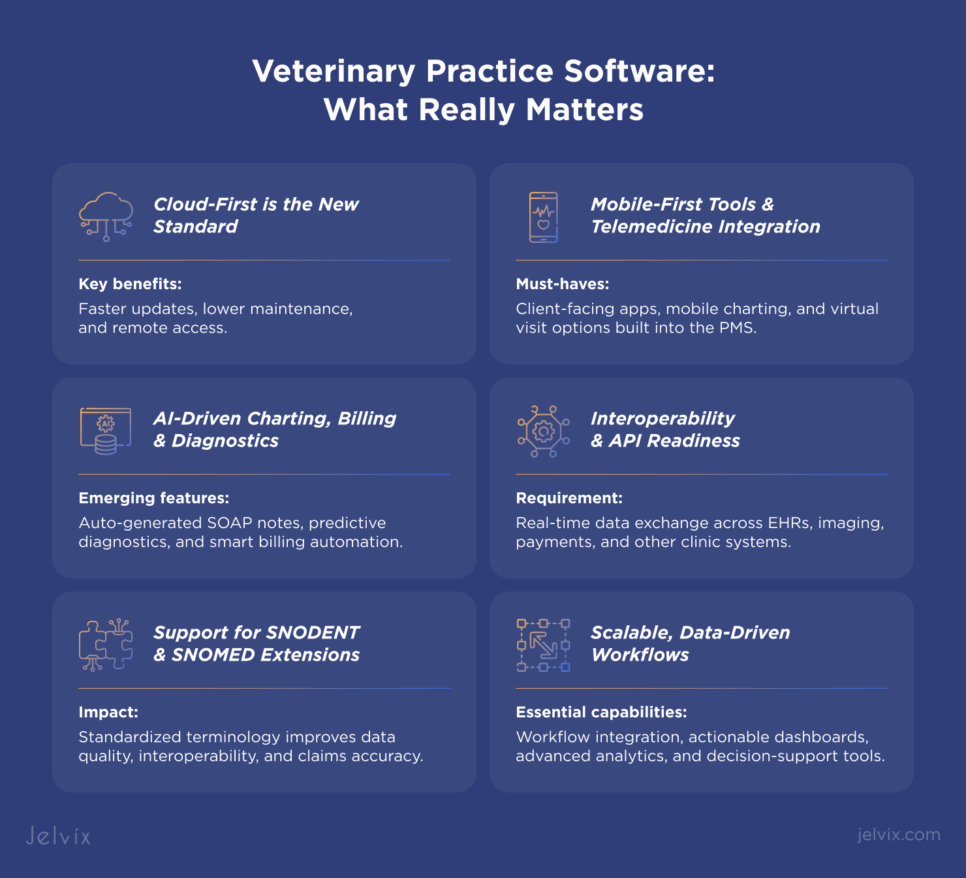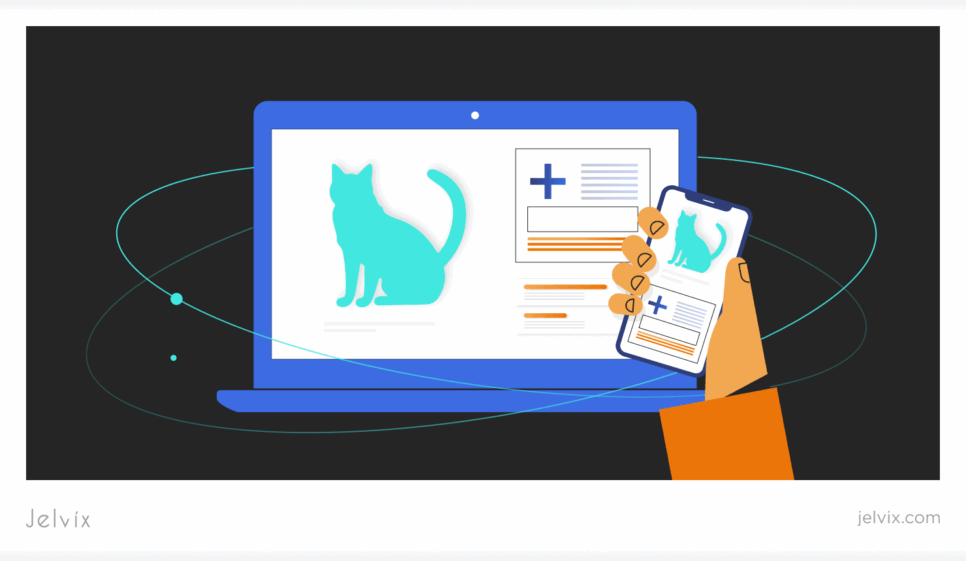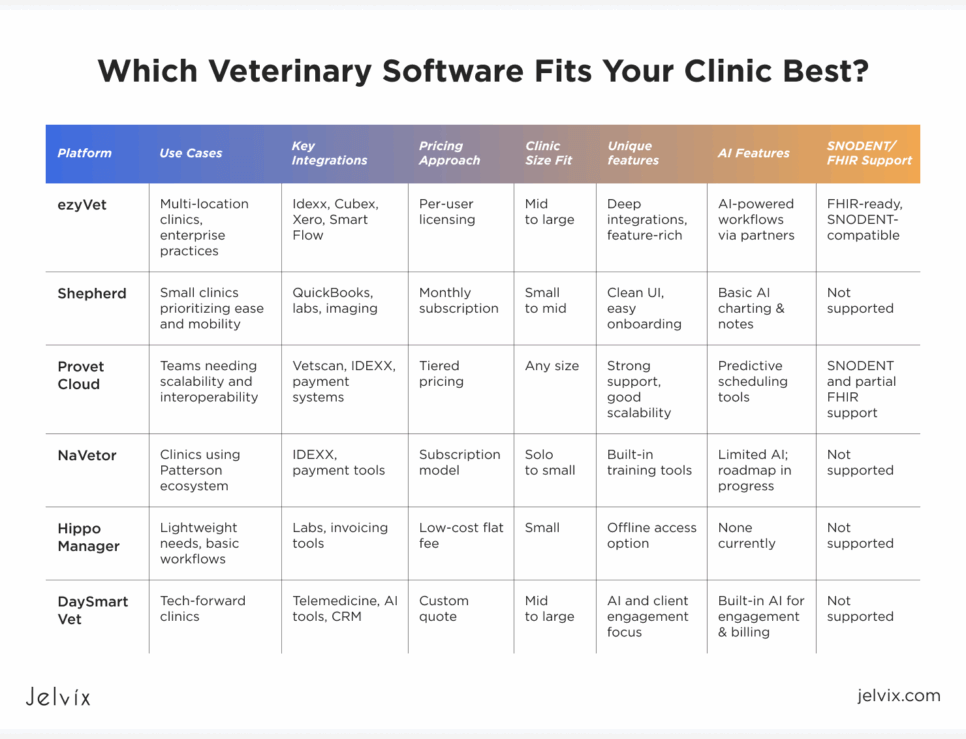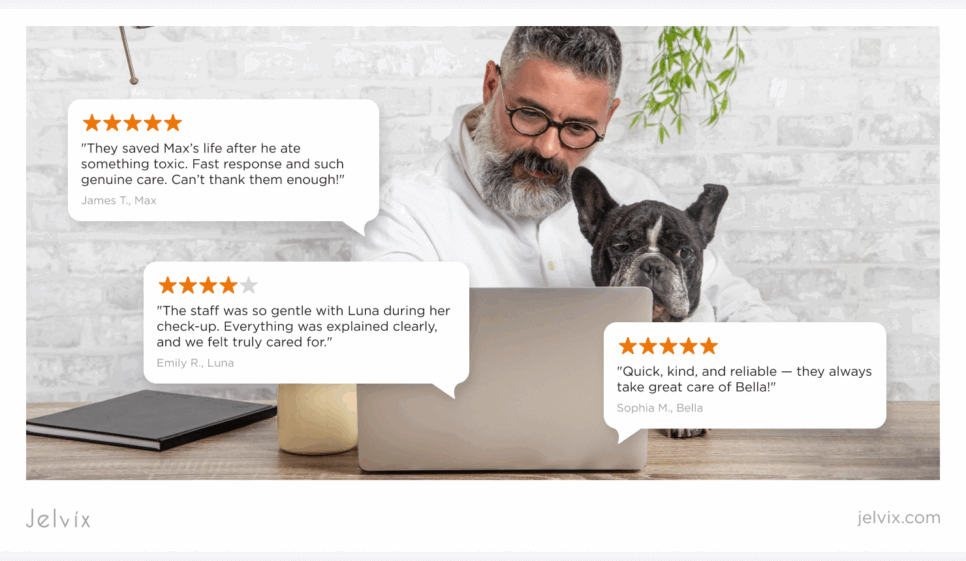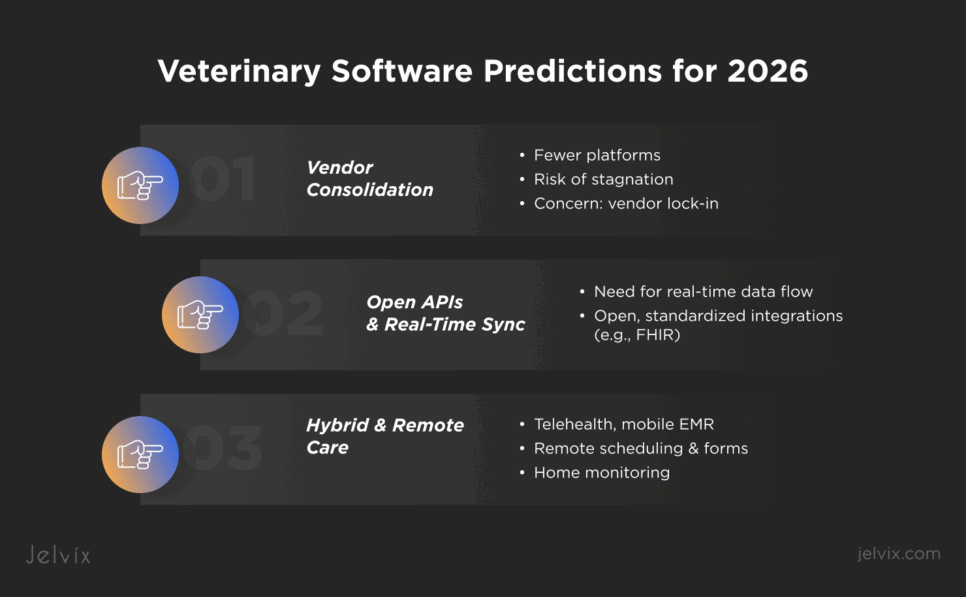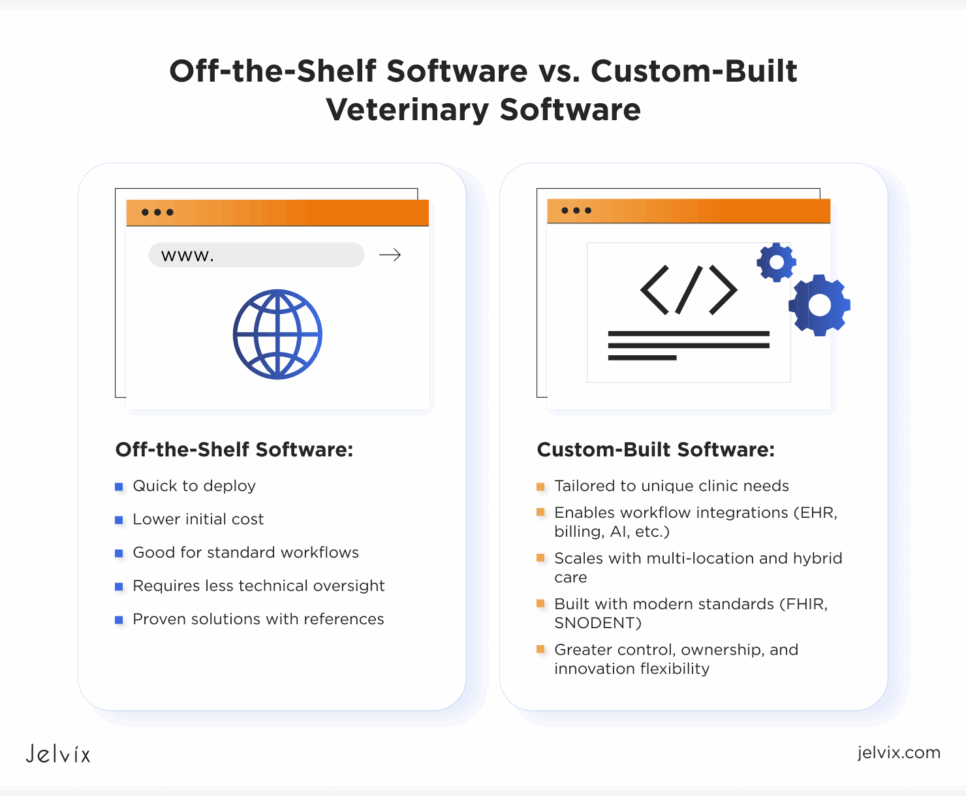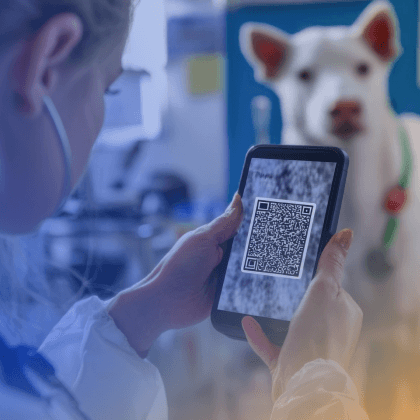Veterinary software has come a long way. A few years ago, most clinics just needed basic tools to book appointments and track invoices. Today, practices face new priorities like integrating AI-based custom enterprise solutions into clinical workflows, aligning with FHIR standards, and making sure everything works seamlessly on mobile devices.
With growing patient loads, remote consultations, and rising expectations for connected care, older systems can’t keep up. Slow interfaces, limited healthcare data integration, and poor info exchange with labs and imaging tools are becoming critical. That’s why practices are reviewing their entire tech stack and seeking cloud veterinary software that can scale with them.
If you’re a clinic owner, practice manager, or tech lead looking to get your systems ready for the challenges of 2025-2026, read this guide. You’ll dive into a veterinary software comparison of platforms like ezyVet, Shepherd, and Provet Cloud to find out how well these apps for veterinarians meet today’s demands and correspond to your long-term goals
The Must-Have Features in Veterinary Practice Software in 2025
Veterinary practices in 2025 are making software decisions based on flexibility, speed, and the ability to integrate with modern tools and technologies. What worked a decade ago is outdated now, and veterinary clinics need to adapt by integrating relevant software.
Growing Popularity of Cloud Veterinary Software
Over 62% of veterinary clinics have adopted cloud or web-based practice management systems. This shift offers faster updates, lower maintenance, and remote access — all essential for growing practices with distributed teams or multi-location operations.
Rise of Mobile-First Tools and Telemedicine Integration
The mobile veterinary software and veterinary telehealth market are growing at an annual rate of over 20%, with platforms expected to reach $921.4 million by 2030. Clinics now expect client-facing apps, mobile charting, and virtual visit options built into their PMS.
Discover a practical guide to healthcare mobile app development, focused on building secure, user-centered solutions for modern care.
AI-Assisted Charting, Billing, and Diagnostics
The market of AI animal hospital software was valued at $1.12 billion in 2024 and is projected to more than double by 2030. From automated SOAP note generation to predictive diagnostics, clinics increasingly opt for AI software development and choose platforms with native AI features or integrations.
Interoperability and API Readiness
With clinics relying on multiple systems, from imaging to payments, modern veterinary scheduling software must support real-time data sharing. Platforms without API integration for veterinary SaaS or FHIR-readiness risk falling behind as integration demands grow across the whole care ecosystem.
What’s more, SNODENT (Systematized Nomenclature of Dentistry) and SNOMED extensions help vet clinics standardize terms for diagnoses and procedures. Supporting them improves data quality, interoperability, and claims accuracy.
Support for Scalable and Data-Driven Care
Beyond features, clinics need platforms that grow with them. In 2025–2026, software should support integration with existing workflows, enable smarter treatment through real-time insights, and make data actionable through dashboards, analytics, or decision-support tools.
Breaking Down Software for Veterinarians: ezyVet, Shepherd, Provet Cloud, and Other Tools
Choosing the right software for veterinary clinics can be a challenging task. The market offers numerous options, and each platform comes with its own strengths and limitations, especially when it comes to integration and mobile compatibility. Below, we break down the best tools for vet clinic staff onboarding to help you find the best fit for your team, workflow, and long-term goals.
ezyVet
ezyVet offers one of the most integration-ready ecosystems on the market. With a strong set of RESTful APIs, it supports third-party tools like labs, diagnostics, and accounting platforms. While not natively FHIR-based, integrations can be built around existing architecture. Mobile access is available but limited in scope.
Integration and API: Well-documented APIs with support from Zoetis-backed dev ecosystem.
Mobile Support: Browser-based, not fully optimized for mobile workflows.
FHIR/SNODENT: No native FHIR support, partial mapping possible with custom work.
Best Fit: Multi-location clinics and enterprise teams needing extensibility and interoperability.
Shepherd Software
Shepherd focuses on user-friendly design and quick deployment. While its API capabilities are more limited, the platform supports essential integrations. Its mobile UX is one of the strongest among vet PMS tools, with intuitive interfaces for clinicians.
Integration and API: REST API available, but limited to select endpoints.
Mobile Support: Optimized for tablets and phones, providing fast clinical access.
FHIR/SNODENT: Not supported..
Best Fit: Small clinics prioritizing mobility and ease of use over deep integration.
Provet Cloud
Among the tools veterinarians use, Provet Cloud stands out for its scalable API layer and ongoing support for HL7 and FHIR standards. Its open architecture makes it suitable for multi-site rollouts, real-time data sync, and advanced analytics. Mobile responsiveness is strong, though native apps are limited.
Integration and API: Mature REST API ecosystem, supports HL7 and partial FHIR models.
Mobile Support: Responsive web UI, accessible on most devices.
FHIR/SNODENT: Partial support available.
Best Fit: Teams focused on scalability, automation, and system interoperability.
NaVetor
NaVetor integrates well within the Patterson ecosystem but offers limited external API flexibility. Mobile access is functional but not advanced, and it lacks standardized data formatting.
Integration and API: Strong internal sync, but limited third-party extensibility.
Mobile Support: Basic, better suited to desktop use.
FHIR/SNODENT: Not supported.
Best Fit: Practices needing stability within the Patterson suite, not custom integrations.
Hippo Manager
Hippo Manager emphasizes affordability and simplicity, with basic API options. While mobile browser access is solid, it lacks formal FHIR or SNODENT alignment. Integrations typically require manual effort or paid add-ons.
Integration and API: Limited, primarily for billing and scheduling.
Mobile Support: Browser-based, functional on most devices.
FHIR/SNODENT: Not available.
Best Fit: Clinics needing a lightweight PMS without complex interoperability.
DaySmart Vet
DaySmart Vet animal hospital software is designed around marketing and client communication. API access exists but is less transparent. While the platform supports mobile-friendly dashboards, it doesn’t emphasize clinical interoperability or healthcare standards.
Integration and API: Select APIs exist, limited developer transparency.
Mobile Support: Strong for client communication, less for clinical use.
FHIR/SNODENT: Not supported.
Best Fit: Clinics focused on client engagement rather than clinical system depth.
Comparing the Best Veterinary Practice Management Software: Which Platform Fits Your Clinic Best?
With so many platforms on the market, it can be hard to determine which veterinary scheduling software fits your clinic’s needs without hours of research. That’s why our experts created a quick comparison table so that you can see the essentials in one place.
As you can see, each veterinary practice software serves a distinct clinic profile. ezyVet caters best to multi-location or enterprise clinics that need strong API access and integrations. Shepherd works well for smaller teams, prioritizing fast onboarding and mobile access, while Provet Cloud stands out for clinics scaling across teams or sites with partial FHIR support.
NaVetor suits practices already using Patterson tools. Hippo Manager is ideal for budget-conscious startups, while DaySmart Vet focuses on practices that value client marketing and engagement. Choose based on how well each system aligns with your technical ecosystem and workflow needs.
Software for Veterinarians: Real-World User Reviews in 2025
To help you out with the decision, our researchers examined dozens of recent veterinary software reviews from G2, Capterra, forums, and veterinary communities, highlighting common praise and pain points across different practice types.
Intuitive UI and Easy Onboarding
Shepherd and NaVetor are frequently praised for their simple, user-friendly interfaces and minimal training time. These qualities make them a strong fit for solo practitioners, mobile vets, or animal shelters where staff rotation is high and fast onboarding is key.
Responsive Customer Support
Users appreciate Shepherd’s live chat with veterinary-trained staff and Provet Cloud’s quick, knowledgeable support team. Clinics without in-house IT especially value this hands-on assistance to keep operations running smoothly without long delays.
Deep Integration and Customizable Workflows
ezyVet and Provet Cloud stand out for seamless integration with lab systems, imaging tools, and finance software. Specialty and multi-location clinics highlight how these platforms reduce manual work and allow for fine-tuned workflows across complex operations.
Scalability for Growing Practices
For expanding networks or multi-site clinics, ezyVet offers strong scalability, even if it comes with a steeper learning curve. Provet Cloud also receives high marks from users scaling their operations, thanks to flexible pricing and broad configuration options.
Challenges with Syncing EMR, Billing, and Scheduling
Many clinics report issues with disconnected workflows. ezyVet handles this best, with strong native integrations that sync clinical notes, invoicing, and appointments. Provet Cloud also offers solid syncing with customizable billing and scheduling rules. Shepherd and NaVetor cover the basics but may lack depth for complex operations.
Expert Take: Trends That Will Shape Veterinary Practice Software in 2026
Software platforms for mobile vet clinics are evolving quickly, and 2026 will push vendors to collaborate more openly and meet growing expectations around usability, connectivity, and innovation.
Vendor Consolidation and Innovation Gaps
Many clinics are running into the limits of legacy systems that can’t keep up with modern needs like AI, mobile tools, or real-time sync. As bigger players buy out smaller platforms, the risk is stagnation with fewer new features, slower updates, and less choice for clinics. Decision-makers are increasingly cautious about vendor lock-in and want software for veterinary clinics that evolves with their business.
Demand for Real-Time Data and Open API Ecosystems
Whether it’s syncing with imaging tools, pulling lab results, or integrating billing platforms, real-time interoperability is now a baseline expectation. Clinics want platforms that speak the same language across systems — using open APIs, standardized data formats like FHIR, and well-documented developer access. SaaS tools that don’t support this are quickly falling behind.
Hybrid Care and Remote Workflow Support
Telehealth is no longer a nice-to-have. From video consultations to home monitoring, hybrid care models are transforming the way clinics operate. Software platforms must support remote scheduling, digital forms, secure messaging, and mobile EMR access. The most competitive vendors are investing in practice management software with AI features and flexible infrastructure that helps clinics care for patients beyond the exam room.
When To Switch from Off-the-Shelf to Custom-Built Software for Veterinarians
No software platform covers every workflow perfectly. For many clinics, especially those with complex operations, multi-location setups, or unique care models, off-the-shelf veterinary software often falls short.
That’s when integration engineering and custom veterinary software development can save the situation. Instead of switching platforms entirely, clinics can build bridges between the systems they already use. By connecting their EHR, billing, scheduling, and even AI tools, they gain a seamless workflow without giving up their preferred tools.
How Jelvix Can Assist: Integrations, Customization, and Scaling with Tech Partners
At Jelvix, we work with veterinary SaaS businesses and clinics in other specialties to fill the gaps that off-the-shelf platforms can’t reach by providing custom medical software development services.
Our recent case involves building a complex, AI-powered veterinary platform from the ground up for a U.S.-based tech provider. The client wanted smart scheduling, voice-to-text note taking, real-time dashboards, and automated billing and inventory. We delivered a secure cloud veterinary software that integrated labs, EHR, payroll, and client sentiment tools, all within HIPAA- and GDPR-compliant architecture.
With custom engineering, FHIR-ready APIs, and AI enhancements, we helped the client modernize their infrastructure and scale their solution across multiple clinic types.
Choosing the Best Veterinary Practice Management Software for Your Goals
In 2026, the choice of a veterinary software will mostly depend on infrastructure rather than on user interface or surface features. Clinics are increasingly evaluating platforms based on how well they support interoperability, open APIs, mobile workflows, and alignment with standards like FHIR and SNODENT.
Tools like ezyVet, Shepherd, and Provet Cloud can be effective depending on your clinic’s architecture and long-term strategy. However, no platform covers every use case. If your workflows involve multiple systems or specialized data exchange, the ability to integrate and scale should be a core selection criterion.
When no off-the-shelf solution meets your requirements, consider working with an experienced technology partner to extend or build the functionality you need. If you need help on aligning vet software with your infrastructure for growth and innovation, reach out to our experts. They will help bridge the gaps and build a custom vet system that works for your team today and in the future.
FAQ: Veterinary Software in 2025
Which veterinary software is right for my clinic in 2025?
The best veterinary software depends on your clinic’s size and needs. For example, ezyVet offers strong enterprise features, while Shepherd is praised for simplicity. Provet Cloud provides flexible, scalable tools. Evaluate based on workflow fit, integrations, and team adoption speed.
Which veterinary management software is best for multi-location clinics?
Provet Cloud and ezyVet are strong options for multi-location practices. Both offer cloud-based access, centralized data management, and scalable workflows to support large teams and multiple sites.
What features should I look for in veterinary scheduling software today?
Look for cloud-native architecture, API integrations, mobile support, AI-assisted charting, and strong customer service. Interoperability and automation are key to reducing manual work and improving care coordination.
Can I integrate imaging, billing, and EMR systems into existing animal hospital software?
Yes, many modern platforms offer API access for integrating imaging, billing, and EMR systems. If the platform lacks native support, custom integrations may be required to ensure real-time data flow.
When should a clinic consider building custom software for veterinarians?
Consider custom software when off-the-shelf options can’t meet workflow needs, especially for unique care models or advanced data handling. Custom solutions offer full control over features, integrations, and scalability.
Ideas need execution.
We build software that works — and works for you.


